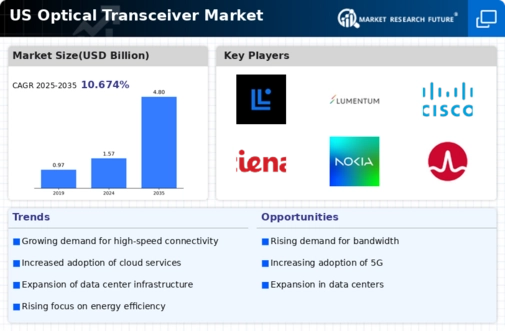The optical transceiver market is currently characterized by intense competition and rapid technological advancements. Key growth drivers include the increasing demand for high-speed data transmission, the expansion of data centers, and the proliferation of cloud computing services. Major players such as Finisar (US), Lumentum (US), and Broadcom (US) are strategically positioned to leverage these trends. Finisar (US) focuses on innovation in product development, particularly in high-capacity transceivers, while Lumentum (US) emphasizes mergers and acquisitions to enhance its technological capabilities. Broadcom (US) is actively pursuing partnerships to expand its market reach, collectively shaping a competitive environment that is both dynamic and multifaceted.
In terms of business tactics, companies are increasingly localizing manufacturing to mitigate supply chain disruptions and optimize operational efficiency. The market structure appears moderately fragmented, with several key players exerting considerable influence. This fragmentation allows for a diverse range of products and services, fostering innovation while also intensifying competition among established and emerging firms.
In October 2025, Finisar (US) announced the launch of its latest line of 400G optical transceivers, aimed at meeting the growing demands of data centers. This strategic move is significant as it positions Finisar (US) at the forefront of high-speed data transmission technology, potentially enhancing its market share in a rapidly evolving landscape. The introduction of these advanced products may also catalyze further innovation within the sector, prompting competitors to accelerate their own development efforts.
In September 2025, Lumentum (US) completed the acquisition of a leading optical components manufacturer, a move that is likely to bolster its product portfolio and enhance its competitive edge. This acquisition underscores Lumentum's commitment to expanding its technological capabilities and market presence, suggesting a strategic focus on vertical integration that could yield long-term benefits in terms of cost efficiency and product innovation.
In August 2025, Broadcom (US) entered into a strategic partnership with a major telecommunications provider to develop next-generation optical networking solutions. This collaboration is indicative of Broadcom's strategy to leverage partnerships for technological advancement and market expansion. By aligning with key industry players, Broadcom (US) is likely to enhance its competitive positioning and drive innovation in optical transceiver technology.
As of November 2025, current trends in the optical transceiver market include a strong emphasis on digitalization, sustainability, and the integration of artificial intelligence (AI) into product offerings. Strategic alliances are increasingly shaping the competitive landscape, enabling companies to pool resources and expertise. Looking ahead, competitive differentiation is expected to evolve, with a notable shift from price-based competition to a focus on innovation, technology, and supply chain reliability. This transition may redefine market dynamics, compelling companies to prioritize advanced solutions and sustainable practices to maintain a competitive edge.
















Leave a Comment